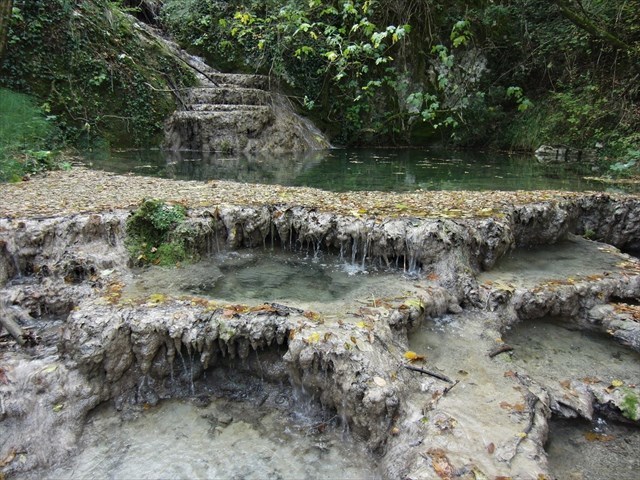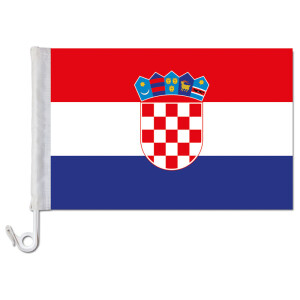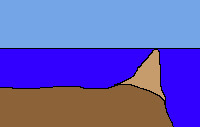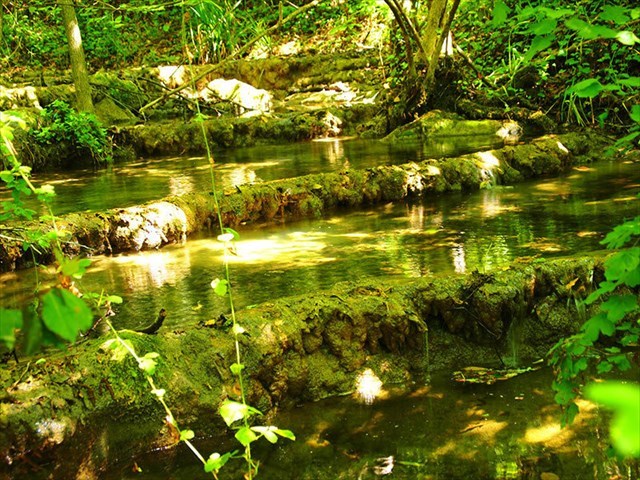 © akol
© akol

A big, big Thank You to *vontere* who helped me with the translation!
.
Općenito
Sedrene barijere su prirodni fenomen prisutan u mnogim krškim rijekama/potocima bogate otopljenim kalcijevim bikarbonatom Ca(HCO3)2. Iz ovakve mineralizirane vode može doći do izlučivanja kalcijevog karbonata CaCO3 u obliku sitnih kristala koji se zatim talože, pogotovo kod sporog toka vode. Rezultat ovakvog kontinuiranog procesa taloženja su vapnenačke sedrene barijere.
 (2)
(2)
Detaljnije o nastajanju
Znanstveno se proces nastajanja sedrenih barijera naziva karbonatno taloženje. Karbonatna voda pri plitkom toku polako isparava, time se povećava količina ugljičnog dioksida CO2, a pošto voda može samo dio CO2 otopiti, višak plina se oslobađa, a također oslobađa se u malim razmjerima pri prelasku barijera, gdje onda ostaje kalcijev karbonat koji se taloži u obliku mikro kristala iz koje polako nastaju sedrene barijere.

Sedrene barijere ne rastu jednakom brzinom. Ako nizvodna barijera raste brže od uzvodne, može doći do većeg vodostaja te poplavljivanja uzvodne barijere i nastaju dva manja bazena različitog oblika.
Biljke potpomažu stvaranju sedre i to tako da hvataju plutajuće kristaliće, a dok s druge strane fotosintezom uklanjaju ugljični dioksid iz vode čime nastaje kalcij karbonat.
 (3)
(3)
.
Čestice koje još plutaju i nisu se staložile odgovorne su za boju vode. Primjer za to je maleno jezerce u blizini vodopada (Waypoint!). Zbog najfinijih čestica jezerce je smaragdne boje i vrijedno je posjeta.
Zadaci
Da biste logirali ovaj earth cache kao nađen, molimo vas da mi svoje odgovore pošaljete putem poruke preko mog profila. Nakon čega možete odmah logirat cache, ako nešto nije u redu s odgovorima budem vas kontaktirao.
Pitanje 1)
Koliko barijera možeš ovdje u potoku vidjet?
Pitanje 2)
Koliko je velika najveća barijera (promjer)?
Pitanje 3)
Opiši površinu barijere (hrapavost, boja, …)
Neobavezno
Veselilo bi me da svom logu priložiš fotografiju.

Allgemeines
Sinterbarrieren – auch Sinterstufen genannt - sind ein natürliches Phänomen in vielen Karstflüssen mit gelöstem Calciumbicarbonat Ca(HCO3)2. Aus diesem mineralisierten Wasser kann es zur Ausscheidung von Calciumcarbonat CaCO3 in Form von kleinen Kristallen kommen, vor allem bei niedrigen Strömungsgeschwindigkeiten. Das Ergebnis dieses kontinuierlichen Sedimentabscheidungsprozesses sind Sinterbarrieren aus Kalkstein.
 (2)
(2)
Genauere Entstehungsgeschichte
Der wissenschaftliche Ausdruck für den Prozess der Sinterbarrieren-Bildung nennt sich Karbonatfällung. Das karbonisierte, flach fließende Wasser verdunstet hierbei geringfügig. Dadurch wird die Menge an Kohlendioxid CO2 erhöht. Da das Wasser nur einen geringen Teil an CO2 lösen kann, wird das überschüssige Gas frei. Ebenso entweicht es kleinräumig beim Überfließen der Stufen in die Umgebung. Übrig bleibt Calciumcarbonat, welches in Form von Mikrokristallen ausgeschieden wird. Aus diesen bauen sich langsam die Barrieren auf.

Barrieren wachsen nicht alle mit der gleichen Geschwindigkeit. Wenn die nachgeschaltete Barriere schneller wächst als die vorgeschaltete, kann diese durch den erhöhten Wasserstand die vorgeschaltete Barriere überschwemmen. Daraus ergeben sich zwei kleinere Gewässer, die in verschiedenen Formen zueinander angeordnet sein können.
Pflanzen fördern den Sedimentationsprozess. Sie fangen einerseits schwebende Kristalle ein, andererseits entfernen sie durch Photosynthese Kohlendioxid aus dem Wasser, wodurch sich das Calciumcarbonat bildet.
 (3)
(3)
.
Noch nicht sedimentierte Partikel sind für die Farbe des Wassers verantwortlich. Ein Beispiel dafür ist der kleine See beim Wasserfall (Waypoint!). Dieser erscheint aufgrund feinster Partikel smaragdfarben und ist auf jeden Fall einen Besuch wert!
Logaufgaben
Um den Earthcache als gefunden loggen zu können, musst du mir die Antworten auf die nachfolgenden Fragen senden. Danach kannst du den Cache sofort als gefunden loggen, wenn etwas bei den Antworten nicht stimmt melde ich mich.
Frage 1)
Wie viele Barrieren kannst du hier im Bach erkennen?
Frage 2)
Wie groß ist die größte dieser Barrieren?
Frage 3)
Beschreibe die Oberfläche der Barrieren (Rauigkeit, Farbe, etc.)
Optional
Ich würde mich freuen, wenn du deinem Log ein Foto anhängen würdest.

general information
Sinter barriers are natural buildings in many karst rivers containing calciumbicarbonate Ca(HCO3)2. Calcium carbonate CaCO3 in the form of small crystals can be precipitated from the mineralized water, especially if the river has low flow rates. The result of this continuous sediment deposition process is sinter barriers - made of limestone.
 (2)
(2)
more detailed
The process of building the sinter barriers is called “carbonate precipitation“. The carbonated, flat-flowing water evaporates marginally. This increases the amount of carbon dioxide CO2. Since the water can only dissolve a small amount of CO2, the oversaturated gas evaporates. Another little amount of the gas can escape when the river flows over the barriers. Calcium carbonate remains in the water, gets precipitated in the form of microcrystals and slowly builds up the barriers.

Not all barriers are built at the same speed. If the downstream barrier grows faster than the upstream one, it can float the upstream barrier due to the increased water level. This results in two smaller waters pools.
Plants promote the sedimentation process. On the one hand they make the floating crystals sink down, and on the other hand they remove carbon dioxide from the water by photosynthesis, a condition to precipitate the calcium carbonate.
 (3)
(3)
.
Particles that are still floating in the water are responsible for its color. An example of this is the small lake near the waterfall (Waypoint!). Due to the finest particles the lake appears emerald and is definitely worth a visit!
log conditions
In order to say "Found it", you have to send me the answers of the following questions. After that you can log the cache immediately. If something is wrong, you will hear from me.
Question 1)
How many barriers can you see in the rivulet?
Question 2)
What is the diameter of the biggest barrier?
Question 3)
Describe the surface of the barriers (roughness, color, etc.)
Optional
A picture of you or of the landscape would be very nice!
Happy Caching wünscht
.GeoJoe.
sources
(1) Tourist Board “Sentonina Staza“
(2) https://hr.wikipedia.org/wiki/Sedrena_barijera
(3) http://www.rabac-labin.com/hr/165-sentonina-staza-labin-rabac
(4) https://sites.google.com/site/plitvickajezeraskolehr/home/sedrene-barijere
(5) http://www.crorivers.com/obiljezja_krske.php
(6) http://www.spektrum.de/lexikon/geowissenschaften/sinterstufe/15028